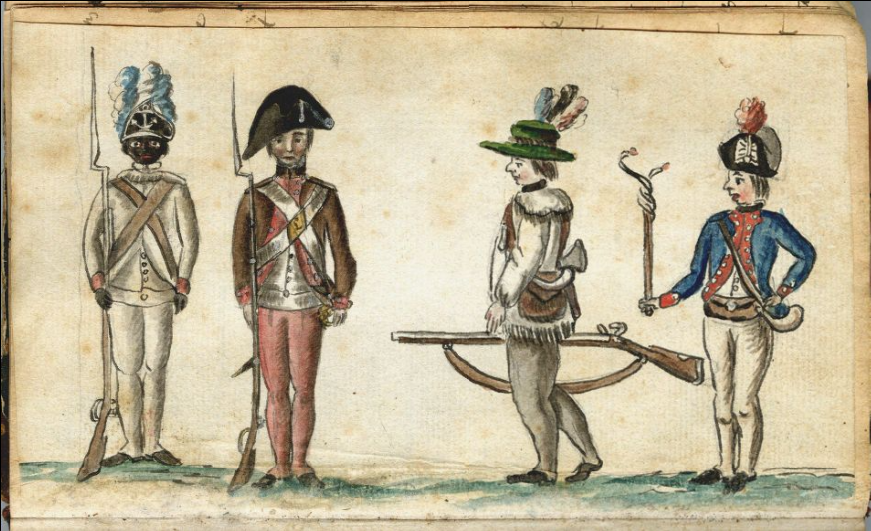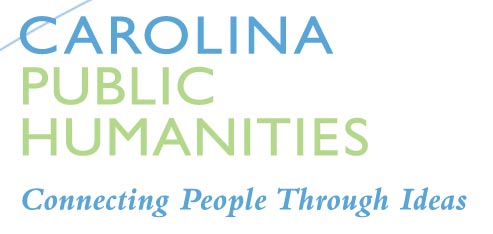The story of how the original thirteen American colonies broke away from Great Britain and formed the United States is well known. Less well known is how Black people in the colonies felt and what they did during the War of Independence.
At the time of the American Revolution, enslaved people made up at least 25 percent of the population of North Carolina. In actual numbers, Black people totaled perhaps seventy thousand but no more than 5 percent of them were free. Most Black people, enslaved or free, lived in the countryside and worked the land, planting, harvesting, and preparing crops for market. Those who lived in North Carolina's few towns worked at trades or were personal servants to enslavers. A few of them were "hired out" by their enslavers to work for others who used their labor. All of their earnings, except perhaps for a small allowance, went directly to their enslavers.
Enslaved people with special skills worked as carpenters, coopers (making barrels), blacksmiths (making iron into tools and shoeing horses), wheelwrights (making and repairing wheels), and in many other skilled, trade occupations. In coastal towns, such as Wilmington and New Bern, they worked in trades that were important to the shipping business. Also in these towns, they may have controlled parts of the local economy, for example, selling almost all the food staples, fish, and fowl (birds).
Just as white people were divided by the conflict between the colonies and England, Black people too faced difficult choices. Black people in the colonies fought for both sides, providing support to both the British and the revolutionaries. Their actions during the war were often decided by what they believed would best escape enslavement. Most believed that victory by the British would lead to the end of their enslavement.
Fears of enslaved peoples' revolt in the South
Fears of a revolt from enslaved people gripped the South. Before the war, British military leaders recognized that the southern colonies could be greatly weakened by an uprising of enslaved people against their enslavers. The white colonists knew this, too. Joseph Hewes, one of North Carolina's signers of the Declaration of Independence, accused the British of planning to "let loose Indians on our Frontiers" and to "raise the Negroes against us," a plot that included arming enslaved people. James Iredell of Edenton charged the British with "exciting [enslaved people] to cut our throats, and involve the Men, Women and Children in one universal Massacre." Edenton and Wilmington organized patrols to keep careful watch on Black residents at night.
Enslaved people, however, did not need encouragement to strike for freedom. In every colony from Maryland to Georgia, enslaved people weighed their chances for freedom and seemed on the edge of revolt. Massachusetts revolutionary John Adams commented on a "grapevine" that spread news among enslaved people: "The [N]egroes have a wonderful art of communicating intelligence among themselves; it will run several hundreds of miles in a week or fortnight [two weeks]."
Insurrection plot planned by Enslaved People in North Carolina, 1775-1776 and Lord Dunmore's Proclamation
Aroused perhaps by British promises of freedom, enslaved people in Pitt and Beaufort counties tried to break the chains of bondage. In July 1775, the Pitt County Committee of Safety discovered a plot for an insurrection among enslaved people just before it was to start. A posse of one hundred men captured the suspected leaders and jailed more than forty Black people. The same month other Black people were captured along the Pitt-Craven county line. Their plan, according to the confessions (probably obtained through torture), was to "destroy the family where they lived" and then to march "from House to House (Burning as they went) until they arrived in the Back Country." There they were to be welcomed by the British who would reward them by settling the formerly enslaved people "in a free government of their own."
Meanwhile, in Virginia, the royal governor, Lord Dunmore, promised freedom to all the enslaved people and indentured servants of revolutionaries who would take up arms and fight for "His Majesty's crown and dignity." The effect was electric. Immediately, enslaved people rushed to Norfolk to join "Lord Dunmore's Ethiopian Regiment." Across the chest of each Black soldier appeared the words "Liberty to Slaves." During the winter of 1775/1776, Dunmore commanded approximately 2,000 men, half of them Black. At the Battle of Great Bridge near Norfolk in December 1775, North Carolina troops under General Robert Howe fought against the combined British-Black army.
Along the North Carolina coast in the spring of 1776, enslaved people were joining the British. William Hooper, another of North Carolina's signers of the Declaration of Independence, sadly noted, "The [N]egroes are deserting from the Sea Coast... Three of mine were intercepted on their way and are now in Goal [jail]." The muster rolls (lists of people in military units or on ships) of British ships stationed off Cape Fear recorded the names of Black people who "deserted from the Rebels" or "fled for Protection." The HMS Scorpion reported that thirty-six Blackpeople, including at least eleven women, came aboard on March 3, 1776.
The stories of two Black Men, John Provey and Thomas Peters
The stories of two Black men — one enslaved and one free — reveal clearly the commitment among Black people to freedom and removal from a society of enslavement. When John Provey, a free Black person from the lower Cape Fear River region, enlisted in the British army in June 1776, he left all his property behind. After serving during the entire war, Provey filed a request with the British government for help in recovering his lost property. On his list were a "small dwelling House," two horses, a small field of Indian corn and potatoes, a dozen fowl, a dozen ducks, and a bed and household furniture. Provey went to live in London, England.
Thomas Peters, an enslaved person and also a native of the lower Cape Fear River region, joined the British army in 1776. He became a sergeant with the Black Pioneers, a unit of support troops for the British army. When the British evacuated New York in 1783, Peters went with them to Nova Scotia, Canada. There he became the leader of a large group of Black loyalists. This group argued that the British had not lived up to their promises of land grants and fair treatment in exchange for their loyalty and service. Finally, Peters convinced the British to resettle 1,200 Black loyalists in Sierra Leone, Africa, a British colony. There they had their own government, they enjoyed equality as British subjects, and they lived free since slavery was outlawed.
The problem of what to do about both enslaved and free Black people was a continuing concern for the revolutionaries. There was fear of armed Black people, especially in the South.
After Lord Dunmore's proclamation of freedom for enslaved people who joined the British army, the patriots had to consider offering freedom from slavery in exchange for service in their army. When General George Washington saw the brave performance of Black soldiers at Bunker Hill, he took action to bring Black troops into the army.
However, southern states, especially South Carolina, resisted efforts to arm Black people. Only Maryland permitted enslaved people to enlist, but free Black people joined the armies and navies in Virginia, North Carolina, Massachusetts, Delaware, and Connecticut. Perhaps as many as three-fourths of Rhode Island's Continental troops included enslaved people who exchanged their service for freedom.
At White Plains, New York, in August 1778, muster rolls for the Continental army recorded 755 Black people. Fifty-eight of them, probably free men, were with the North Carolina Continental Line. Black soldiers were more likely to serve as laborers and craftsmen. They build fortifications, made weapons and ammunition, cleared roads, and shod horses. They also acted as spies, guides, musicians, or servants to white officers.
North Carolina's most famous Black soldiers
North Carolina's most famous Black soldier was John Chavis, who spent three years in the Fifth Virginia Regiment. After the war, he won fame as a Presbyterian minister and teacher of both Black and white students in Raleigh. In 1832 he declared, "Tell them that if I am Black I am free born American & a revolutionary soldier & therefore ought not to be thrown intirely out of the scale of notice."
Black people who fought with the revolutionaries included Jonathan Overton, who died in 1849 at the age of 101. A newspaper described him as "a soldier of the Revolution" who had "served under Washington, and was at the battle of Yorktown, besides other less important engagements." Another was Ned Griffen, who was purchased by William Kitchen to serve as his substitute in the army. But Kitchen refused to give Griffen his freedom for this service as he had promised. Griffen petitioned the General Assembly, which granted him his freedom "forever hereafter" and gave him the right to vote. And there was the enslaved person named James of Perquimans County who served as a sailor on a Continental ship. He was captured twice by the British, and both times he "Embraced the Earliest Opportunity in Making his Escape to Return to this Country." The county court freed him because he had served on an "American Armed Vessel."
Many Black people looked to the British troops for their liberation. Wherever the British marched, enslaved people followed. When British General Cornwallis invaded the Carolinas in 1780/1781, enslaved people flocked to him. British officers put Black people to work in the service of the king's army performing many of the same duties they carried out in the American army.
During Cornwallis's advance through the Carolinas, he employed Black people to search for food and goods along the way. Their raids sent an alarm through the farms and homesteads of the countryside. Writing from eastern North Carolina in the spring of 1781, Jean Blair reported at least two thousand Black people in different parties had been "sent out by L[ord] Cornwallis to plunder and get provisions. It is said they have no Arms but what they find in the houses they plunder."
Farther west in Rowan County, Cornwallis's movements encouraged another uprising of enslaved people. Black people in Rowan County realized that "War was Coming on," and they began to collect weapons. Their plan was to rise up against the "white people." Enslaved people would have to decide "which side" they were for — "the Americans or the British." Though the plot was discovered in time, it illustrated feelings in the community of enslaved people.
That decision — which side to support — had no neat and simple answer. When the British evacuated Wilmington in November 1781, William Hooper's enslaved people acted in different ways. Three of them left with the British. A fourth, Lavinia, "went on board the fleet... and much against her will was forced ashore by some of my friends, and returned to me," Hooper explained. Lavinia's brother, John, however, resisted British bribes. Though offered clothes, money, and freedom, John refused to leave his enslaver. He "stole through British sentries" and traveled seventy miles to rejoin the Hooper family.
Cornwallis's surrender at Yorktown in October 1781 found thousands of Black refugees who had to be dealt with. On the one hand, the British military (and the patriot forces, as well) had promised freedom for Black people who had helped their cause. On the other hand, there were thousands of loyalist enslavers. The Americans wanted to prevent a mass exodus of Black people from the United States. One British general wrote "... the slaves are exceeding unwilling to return to hard labour, and severe punishment from their former masters." As many as 5,000 Black people sailed with the British from Charleston in late 1782. In New York, the commander of the British army took the position that any Black person who was with the British army before November 30, 1782, would be considered free. American enslavers tried to reclaim their property of enslaved people but had little success. Boston King, a Black Baptist preacher, recalled, "This dreadful rumour [re-enslavement] filled us with inexpressible anguish and terror, especially when we saw our old masters, coming from Virginia, North-Carolina, and other parts, and seizing upon their slaves in the streets of New-York, or even dragging them out of their beds."
In the end, more than 3,000 Black people left from New York with the British, most bound for Nova Scotia in Canada. At least 8,300 Black people were taken to East Florida from Savannah and Charleston. Of course many remained in a state of slavery to loyalists who had fled. But many had earned their freedom during the war.
It is not surprising that when opportunities for freedom arose, more often than not enslaved people fled to the British. Lavinia's liberty ship sailed without her, but thousands of other Black people in the colonies seized their freedom. With the Revolution's language of equality, independence, and liberty, enslaved people needed no introduction to the ideas at the heart of the struggle with Great Britain.


